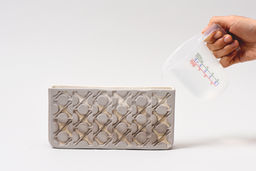Porosity Code
A ceramic visualization instrument triggered by water
Water triggers the captivating patterns of the ceramic piece as time passes by. The porosity of cermaic allows water to be absorbed and released during the wetting and drying process. The varied thicknesses further enhance the visibility of this mesmerizing interplay between water and ceramic.
Working mechanism
To highlight the visual effects created by the interaction between ceramic and water, varying thicknesses are applied to the surface. These differences in thickness affect the material’s ability to absorb water. The contrast in the pattern emerges as the ceramic absorbs water, with thicker areas taking longer to soak. The pattern continuously evolves until the water fully permeates all the pores in the ceramic.



Computational design and fabrication
To achieve a gradient of thickness, I developed a computational design workflow in Grasshopper, enabling intricate pattern designs. For fabrication, I used CNC milling to create precise plaster molds, which allowed slip casting to form detailed variations in thickness. Other methods to enhance visual effects included sandblasting, which engraves specific areas to create thickness, and selective glazing, where unglazed sections are left to absorb color.



Sandblasting
A variation of thickness and pattern can be achieved by sandblasting away materials with stencil.

Selective glazing
Selective glazing can seal some part of the surface so that liquid can only pass through those unglazed parts, triggering the pattern. As water is not very visible, I instead try something that contains pigment. The effect shown here is the result of coffee remaining in the cup for more than one day.




















